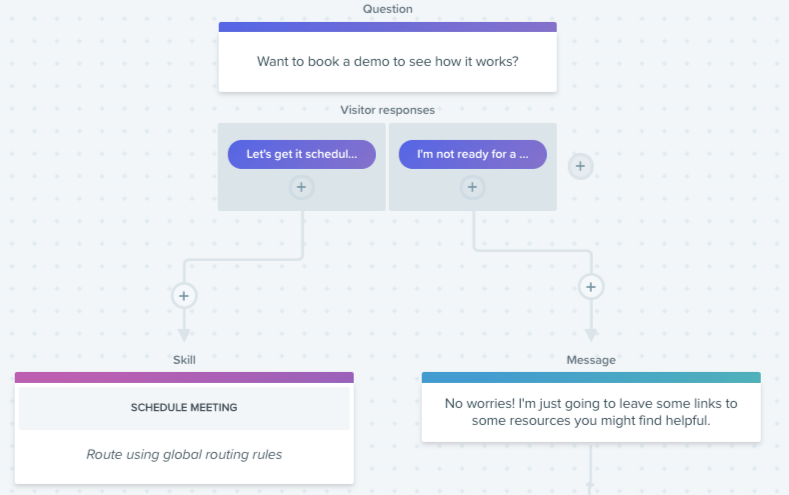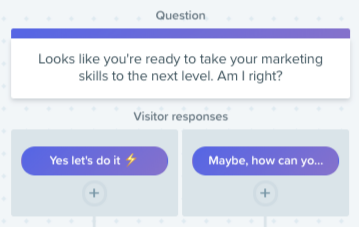If site visitors aren’t engaging with the lead generation tactics you’re employing today, then it might be time to take a different, more conversational approach.
Chatbots provide a potentially lighter and easier way for visitors to engage with your brand in a way that can feel more human than traditional marketing communications.
But while chatbots are more casual and conversational than a form, they still are a form of targeted marketing communications. Playbooks, the scripts automated chatbots follow, should be created with an end goal in mind.
Here are seven steps you should take when developing your chatbot playbook:
1. Build Your Playbook Around a Call-To-Action (CTA)
When building out your chatbot’s conversational strategy, start with the offer you want the conversation to lead to and work backward to develop everything said leading up to that point.
In addition to selecting the ending CTA prior to developing each individual message, choose alternative offers for the site visitor so if they’re not ready to convert on your main CTA, you can still provide value through the conversation.

2. Start with a Strong Opener That References Their Challenge
You’re not going to get any value from a chatbot if nobody interacts with it. Write an opener that’s compelling, enticing and relevant.
To do this, you need to know your buyer personas well: you need to understand the challenges they’re facing and how your solution addresses those challenges so you can craft an opening that taps into that.

3. Deliver Your Value Proposition Early in the Conversation
After your opener generates initial interest in the chat, you need to show what your company can offer the site visitor.
Follow up the opener with a message related to your value proposition. When doing so, continue communicating in the conversational tone you established in your opener. Don’t just paste in your company’s mission statement or solution pitch.
4. Don’t Provide Easy Outs
Throughout your conversation, don’t provide an easy way for your site visitor to end the conversation.
If you’re asking “Are you interested in learning how inbound marketing can increase your ROI?”, the response options available should not include the word “no.” Instead, the negative responses should be less definitive (“maybe” “I’m not sure at this time”) that doesn’t allow the respondent to just opt out of the communication stream they’re in.
This keeps the visitor engaged with the chat and allows you to provide further info.
For example, if you’re asking someone if they want a demo request, the responses could be “yes” or “I’m not sure yet.” If they respond “I’m not sure yet” you can follow up with additional information on your product and related educational resources.
5. Once Someone is Interested in Your CTA, Don’t Add Unnecessary Friction
Once you have someone interested in your main CTA, you don’t want to deter them with too many qualifying questions.
Conversational marketing tools can help with this through integrations that provide you with information about anonymous site visitors.
In a demo request form, you need to ask someone’s name, phone number, email address in addition to qualifying questions about their industry, revenue, company size, etc.
Chatbots can streamline this qualifying process. Drift, for example, gathers all that qualifying information through its Clearbit integration so all you need to ask for is the site visitor’s name and email address. Even the need for a phone number can be eliminated because chatbots can allow you to book time directly on a rep’s calendar.
Reducing the number of questions a site visitor has to answer makes it easier for them to convert.
6. Have a Clear Brand Voice Throughout
Conversational marketing provides one of the best opportunities for marketers to be more human in their communications.
You can express personality in chat in ways you can’t do in a blog post or on a landing page. Take this opportunity to be a little more casual and use emojis — but also stay within your brand’s guidelines.
7. Analyze Performance and Optimize Your Playbook Over Time
When you’re first coming up with openers, you might have a couple of ideas to choose between. When you pick one, don’t just throw out the other options. Jot them down somewhere in case they can be used later.
After your chatbot has been live for a while, analyze its performance. If your playbook isn’t as effective as you hoped, change it.
Continue to tweak and improve your chatbot playbooks over time as you learn what your site visitors respond best to.
Where Should You Put Your Bot?
Think about which of your webpages sees the most traffic from your playbook’s intended audience. For example, your homepage is probably one of your most trafficked pages, so that would be a great place to start with a bot to address general site visitors.
Then, if your solution pages are some of your next most impactful pages, you could create a playbook for each of those. As you learn what works for your company, you can continue to add additional, more targeted playbooks across your site and really flesh out your conversational marketing efforts.